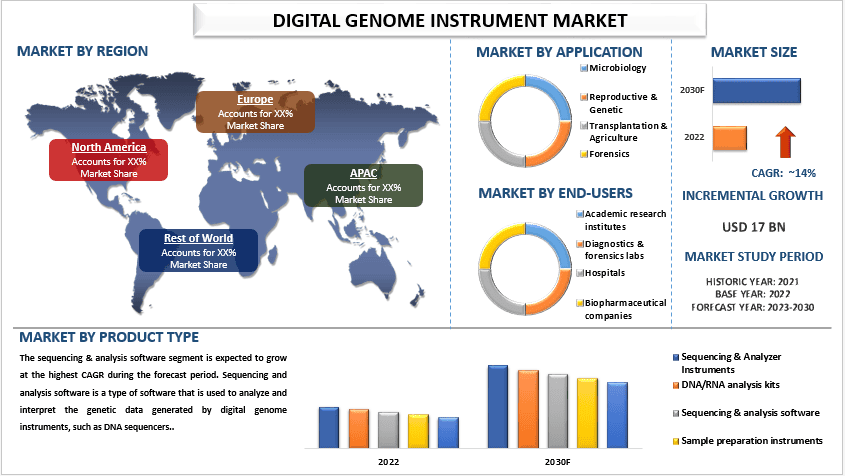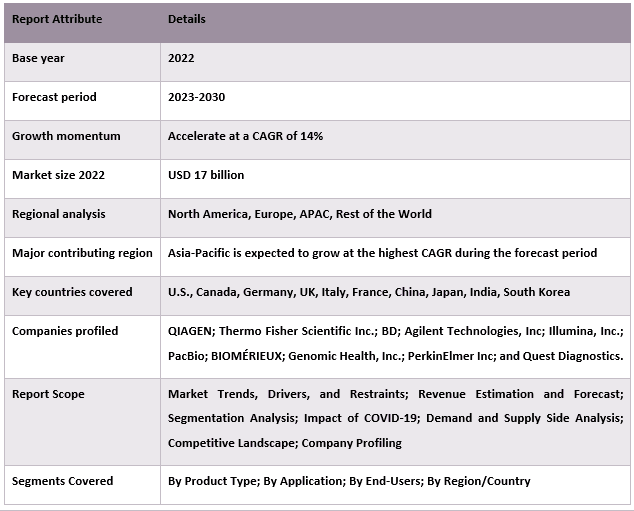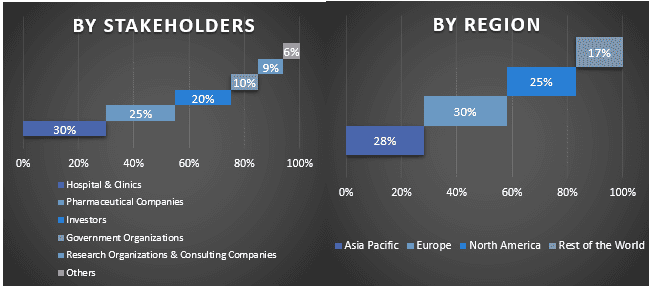- Home
- About Us
- Industry
- Services
- Reading
- Contact Us
Digital Genome Instrument Market: Current Analysis and Forecast (2023-2030)
Emphasis on Product Type (Sequencing & Analyzer Instruments, DNA/RNA Analysis Kits, Sequencing & Analysis Software, Sample Preparation Instruments, and Others); Application (Microbiology, Reproductive & Genetic, Transplantation & Agriculture, and Forensics); End-Users (Academic Research Institutes, Diagnostics & Forensics Labs, Hospitals, and Biopharmaceutical Companies); and Region/Country

The Digital Genome Instrument market held 17 billion in 2022 and is expected to grow at a strong CAGR of around 14% during the forecast period (2023-2030). A digital genome instrument is a device or system that is used to analyze and interpret genetic data. It typically consists of a sequencer, which is used to generate genetic data, and a computer or other software that is used to analyze and interpret the data. Advances in sequencing technology have made it possible to analyze large amounts of genetic data quickly and accurately. This has led to a decrease in the cost of sequencing and an increase in the number of applications for digital genome instruments. Further, genetic testing is becoming more common, as people seek to understand their risk for inherited diseases and genetic disorders. Digital genome instruments are used to analyze the genetic data generated by these tests which is also an important factor responsible for the growth of the market.
Some of the major players operating in the market are QIAGEN; Thermo Fisher Scientific Inc.; BD; Agilent Technologies, Inc; Illumina, Inc.; PacBio; BIOMÉRIEUX; Genomic Health, Inc.; PerkinElmer Inc; and Quest Diagnostics. Several M&As along with partnerships have been undertaken by these players to facilitate customers with hi-tech and innovative products/technologies.
Insights Presented in the Report
“Amongst product type, the sequencing & analysis software segment is expected to grow at the highest CAGR during the forecast period.”
Based on product type, the market is segmented into sequencing & analyzer instruments, DNA/RNA analysis kits, sequencing & analysis software, sample preparation instruments, and others. As per our analysis, the sequencing & analysis software segment is expected to grow at the highest CAGR during the forecast period. Sequencing and analysis software is a type of software that is used to analyze and interpret the genetic data generated by digital genome instruments, such as DNA sequencers. This software is used to analyze the raw data generated by the sequencer and to generate reports and other outputs that may be used for research, clinical diagnostics, or other purposes.
“Amongst applications, the diabetes segment held the dominant share in 2022.”
Based on the application, the market is segmented into microbiology, reproductive & genetics, transplantation & agriculture, and forensics. As per our analysis, the reproductive & genetic segment held the dominant share in 2022. The reproductive and genetic segment of the digital genome instrument market is a rapidly growing field that involves the use of advanced technologies to study and analyze genetic information. The segment includes a range of products and services, such as genetic testing kits, gene sequencing instruments, and reproductive technologies.
Amongst end-user, the homecare settings segment is expected to grow at the highest CAGR during the forecast period.”
Based on end-users, the market is segmented into academic research institutes, diagnostics & forensics labs, hospitals, and biopharmaceutical companies. As per our analysis, the academic research institutes segment is expected to grow at the highest CAGR during the forecast period. In academic research institutes, digital genome instruments are used for a wide range of applications, including genome sequencing, genome assembly, and genome annotation. These instruments are used to study the structure, function, and evolution of genomes, and to identify genetic variations and mutations that can lead to genetic diseases.
“Asia Pacific is expected to grow with the highest CAGR Digital Genome Instrument market during the forecast period.”
The Asia-Pacific region is expected to experience strong growth in the digital genome instrument market due to several factors, including increasing investments in research and development, growing demand for personalized medicine, and increasing awareness of the benefits of genetic testing. In addition to the pharmaceutical industry, academic research institutes in the Asia-Pacific region are also a significant market for digital genome instruments. These institutes are conducting cutting-edge research in areas such as genomics, epigenetics, and personalized medicine, and they are using digital genome instruments to advance their research.
Digital Genome Instrument Market Report Coverage

Reasons to buy this report:
- The study includes market sizing and forecasting analysis validated by authenticated key industry experts.
- The report presents a quick review of overall industry performance at one glance.
- The report covers an in-depth analysis of prominent industry peers with a primary focus on key business financials, product portfolios, expansion strategies, and recent developments.
- Detailed examination of drivers, restraints, key trends, and opportunities prevailing in the industry.
- The study comprehensively covers the market across different segments.
- Deep dive regional level analysis of the industry.
Customization Options:
The global digital genome instrument market can further be customized as per the requirement or any other market segment. Besides this, UMI understands that you may have your own business needs, hence feel free to connect with us to get a report that completely suits your requirements.
Table of Content
Research Methodology for the Digital Genome Instrument Market Analysis (2022-2030)
Analyzing the historical market, estimating the current market, and forecasting the future market of the global digital genome instrument market were the three major steps undertaken to create and analyze the adoption of digital genome instrument in major regions globally. Exhaustive secondary research was conducted to collect the historical market numbers and estimate the current market size. Secondly, to validate these insights, numerous findings and assumptions were taken into consideration. Moreover, exhaustive primary interviews were also conducted, with industry experts across the value chain of global digital genome instrument market. Post assumption and validation of market numbers through primary interviews, we employed a top-down/bottom-up approach to forecasting the complete market size. Thereafter, market breakdown and data triangulation methods were adopted to estimate and analyze the market size of segments and sub-segments of the industry pertains to. Detailed methodology is explained below:
Analysis of Historical Market Size
Step 1: In-Depth Study of Secondary Sources:
Detail secondary study was conducted to obtain the historical market size of the digital genome instrument market through company internal sources such as annual reports & financial statements, performance presentations, press releases, etc., and external sources including journals, news & articles, government publications, competitor publications, sector reports, third-party database, and other credible publications.
Step 2: Market Segmentation:
After obtaining the historical market size of the digital genome instrument market, we conducted a detailed secondary analysis to gather historical market insights and share for different segments & sub-segments for major regions. Major segments are included in the report as product type, application, and end-users. Further country-level analyses were conducted to evaluate the overall adoption of testing models in that region.
Step 3: Factor Analysis:
After acquiring the historical market size of different segments and sub-segments, we conducted a detailed factor analysis to estimate the current market size of the digital genome instrument market. Further, we conducted factor analysis using dependent and independent variables such as product type, application, and end-users of the digital genome instrument market. A thorough analysis was conducted for demand and supply-side scenarios considering top partnerships, mergers and acquisitions, business expansion, and product launches in the digital genome instrument market sector across the globe.
Current Market Size Estimate & Forecast
Current Market Sizing: Based on actionable insights from the above 3 steps, we arrived at the current market size, key players in the global Digital Genome Instrument market, and market shares of the segments. All the required percentage shares split, and market breakdowns were determined using the above-mentioned secondary approach and were verified through primary interviews.
Estimation & Forecasting: For market estimation and forecast, weights were assigned to different factors including drivers & trends, restraints, and opportunities available for the stakeholders. After analyzing these factors, relevant forecasting techniques i.e., the top-down/bottom-up approach were applied to arrive at the market forecast for 2030 for different segments and sub-segments across the major markets globally. The research methodology adopted to estimate the market size encompasses:
- The industry’s market size, in terms of revenue (USD) and the adoption rate of the digital genome instrument market across the major markets domestically
- All percentage shares, splits, and breakdowns of market segments and sub-segments
- Key players in the global digital genome instrument market in terms of products offered. Also, the growth strategies adopted by these players to compete in the fast-growing market
Market Size and Share Validation
Primary Research: In-depth interviews were conducted with the Key Opinion Leaders (KOLs) including Top Level Executives (CXO/VPs, Sales Head, Marketing Head, Operational Head, Regional Head, Country Head, etc.) across major regions. Primary research findings were then summarized, and statistical analysis was performed to prove the stated hypothesis. Inputs from primary research were consolidated with secondary findings, hence turning information into actionable insights.
Split of Primary Participants in Different Regions

Market Engineering
The data triangulation technique was employed to complete the overall market estimation and to arrive at precise statistical numbers for each segment and sub-segment of the global Digital Genome Instrument market. data was split into several segments & sub-segments post studying various parameters and trends in the areas of the product type, application, and end-users in the global digital genome instrument market.
The main objective of the Global Digital Genome Instrument Market Study
The current & future market trends of the global digital genome instrument market were pinpointed in the study. Investors can gain strategic insights to base their discretion for investments on the qualitative and quantitative analysis performed in the study. Current and future market trends determined the overall attractiveness of the market at a regional level, providing a platform for the industrial participant to exploit the untapped market to benefit from a first-mover advantage. Other quantitative goals of the studies include:
- Analyze the current and forecast market size of the digital genome instrument market in terms of value (USD). Also, analyze the current and forecast market size of different segments and sub-segments
- Segments in the study include areas of product type, application, and end-users.
- Define and analysis of the regulatory framework for the digital genome instrument industry
- Analyze the value chain involved with the presence of various intermediaries, along with analyzing customer and competitor behaviors of the industry
- Analyze the current and forecast market size of the digital genome instrument market for the major region
- Major countries of regions studied in the report include Asia Pacific, Europe, North America, and the Rest of the World
- Company profiles of the digital genome instrument market and the growth strategies adopted by the market players to sustain in the fast-growing market
- Deep dive regional level analysis of the industry
Related Reports
Customers who bought this item also bought










